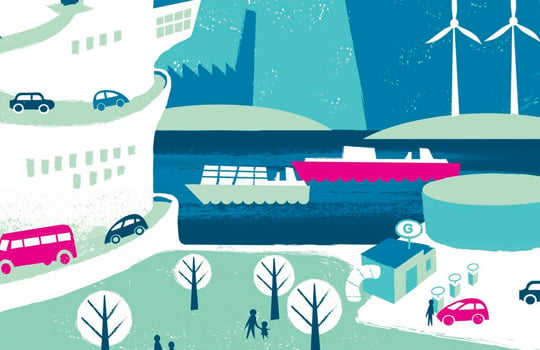Gas, electricity, biofuels, and hydrogen – The future of energy comes in many forms
In the future, energy production will be electrified. Diverse energy options ensure energy sufficiency and its profitable utilization. In addition to direct electrification, renewable electricity can be used to produce other forms of energy, such as hydrogen and synthetic methane. Biogas and other biofuels are needed to complement these.
Climate change, the global geopolitics, and energy shortages are rapidly transforming the field of energy production. Significant change will take place within the next ten years. Compared to current levels, the emissions of industrial companies, for example, must radically decrease by the 2030s to meet climate targets.
But what will energy production look like in the future in terms of different energy sources? According to Mikko Syrjänen, Director of Business Development at Gasum, this can be answered in one word: diverse.
Passenger cars are electrified, HDVs not yet
The EU’s passenger car regulation strongly supports electrification. In the case of passenger cars and light trucks, such as vans, electrification makes technical sense.
"However, as long as internal combustion engine cars are still on the road, biogas will be a good alternative for reducing emissions," says Syrjänen.
However, for heavy-duty vehicles, the situation is different. The energy demand of trucks is significantly higher than that of passenger cars, which sets demanding preconditions for both the size of the batteries and the charging infrastructure.

Picture: Liquefied and compressed biogas are good alternatives for heavy-duty transport.
"At Gasum, we see liquefied and compressed biogas as a viable future energy source for heavy-duty transport. However, this requires the EU's emissions calculation for heavy-duty transport to consider emissions over the entire lifecycle of the fuel. This would enable the production and sale of vehicles using biogas, as their manufacturers are the ones responsible for ensuring that emissions comply with regulations," says Syrjänen.
Read also: Orkla chocolate and chips go by low-emission biogas
Gas is the most viable option for the future of maritime transport
In maritime transport, the situation is more challenging. At present, there is only one energy source that can reduce emissions on a large scale and immediately: liquefied natural gas (LNG). To achieve more significant emission reductions in the future, LNG-fuelled ships may switch to renewable liquefied biogas (LBG) and liquefied synthetic methane.
In maritime transport, electricity can be used only for short ferry routes. Maritime transport on longer routes uses so much energy that the battery sizes required simply couldn’t fit on ships.

"One-third of global shipping tonnage ordered at the moment will be LNG-powered. Therefore, the need for gas in maritime transport will increase significantly. These ships can also utilize renewable gases. In addition to biogas and synthetic methane, liquid biofuels and synthetic fuels made from hydrogen could be used as well, but these are also needed to reduce road and aviation emissions," says Syrjänen.
Another ongoing discussion concerns the potential of ammonia. However, ammonia is toxic, which complicates its processing. In addition, its use would require a leap in the development of engine technology.
Being responsive to demand is important in industrial use
In industrial contexts, there are usually more options for reducing emissions. This means that the use of different energy sources can be more diverse than in traffic or maritime transport. The options available depend a lot on what exactly the energy will be used for. In processes taking place in low-temperature environments (below one hundred degrees Celsius), heat pumps and electricity can be utilized. According to Syrjänen, heavy industry can also utilize hydrogen, for example, in steelmaking and iron reduction.
Electrification is also an attractive option for reducing emissions in many locations. However, as the production of renewable electricity increases, the electricity market will evolve, and electricity prices will fluctuate considerably more than before.
"In industrial use, demand responsiveness for electricity is important. This can mean the use of several alternative energy sources in the same production plant. For example, electricity can be used when doing so is profitable, and the energy source can then be switched to gas when using electricity is not profitable," says Syrjänen.
Alternative energy sources also guarantee an uninterrupted energy supply, which is crucial for production plants. In this case, for example, possible interruptions in the distribution of electricity need not paralyze the entire operation.
Gasum invests in biogas and synthetic methane
Gasum’s offering focuses on its strongest areas of expertise. In the gas business, the aim is to substantially increase the supply of biogas. Gasum is also investing in developing its service offering and increasing its electricity sales, especially in wind power.
Read also: Our platform is supported by three focus areas – biogas, natural gas and power
For future energy production, Gasum considers so-called Power-to-X or P2X solutions—which are synthetic fuels produced with renewable energy—to be important. In Gasum’s offering, this comprises synthetic methane produced with renewable electricity.
Syrjänen points out that Gasum is also exploring the potential of hydrogen. Many of Gasum's customers need hydrogen as a raw material for their processes. However, he adds that hydrogen alone won’t be sufficient to meet all future energy needs.
"Hydrogen is a tricky molecule that is expensive to store and transport. In practice, the utilization of hydrogen in the energy value chain is made easier by further refining hydrogen into a form that is easier to store and transport, such as synthetic methane," explains Syrjänen.



